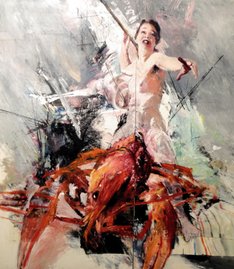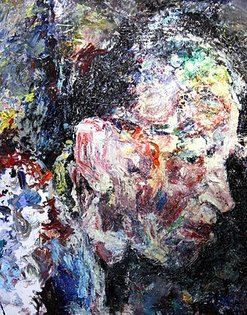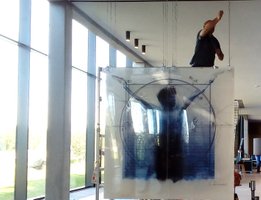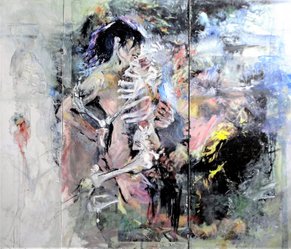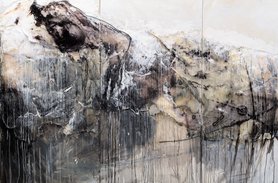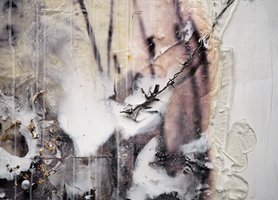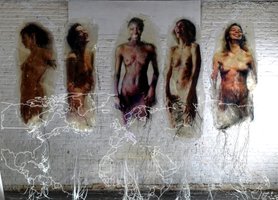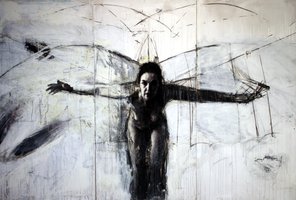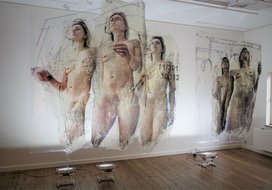Humanist manifestos portrayed.
Em. prof. dr. William Elias November 2021
In 2013, National Geographic (1) published a scientific assertion by archaeologist Dean Snow, who is affiliated to Pennsylvania State University, that the majority of handprints in prehistoric cave paintings come from women. Of course, there are sceptics who question this interpretation - that’s the way it goes in science. Assumptions circulate about the possible origin of art that vary between mental preparation for the hunt and an attempt to ritually please their gods. This in order to reap success in what was probably the main social activity of the time. That the importance of women is taken into account is in itself a step forward in the feminist struggle. Presumably, religion or the psychological need for it is the origin of all forms of culture, both sport and art. Who the first artists were, starting from the oldest known rock drawings, remains guesswork. They drew before they wrote. Texts explaining their art are not likely to be encountered by archaeologists. Whether Dean Snow’s arguments are valid or not, does not matter. It is important in itself, that the rash assumption that this is man’s work has been questioned.
It is noteworthy that these prehistoric acts are associated with modern and contemporary art. It is as if its origins have been rediscovered. Modern art theories about the expressive, the spontaneous and even the abstract, appear to have already been a way of doing in prehistory. The reconciliation with the old art, in the mid-nineteenth century, does not seem to relate to that period, but to the historical evolution in which art became academic, learnable in institutions with the same name, that of the school of philosophy of Plato. That connection is not accidental. The West has remained platonic. It developed an art that was imbued with the rational desire to depict the thought ideally and not the seen reality, in its variety of perceptions and interpretations. Nietzsche pointed to decadence in this regard, a concept to which he ascribed the opposite meaning to that used in everyday language whereby the loss of rational is precisely the interpretation. For Nietzsche, Socrates was decadent because he advocated a world that had to be comprehensible through reason (2). He ignored what Nietzsche saw as the necessary balance between the Apollonian and the Dionysian, between reason and intoxication, understanding and feeling. Before the time of Socrates (469-399) this balance was expressed in the ancient Greek tragedies of Aischylos (525-456 BC) and no longer in Euripides (480-406 BC) where rational explanation prevailed. This digression into the history of theatre is not coincidental. It seems to me that the tragic in the oeuvre of Ulrike Bolenz maintains a fine balance between reason and feeling. She does not dramatize, but dips her brush in the wound of human fate, not imposed by gods, but by the contingent convergence of circumstances.
One cannot blame philosophers for developing a metaphysics of the origin of art, unhindered by any scientific certainty. Georges Bataille (1897-1962), for example, following in Nietzsche’s footsteps, emphasized, without denying the presumed religious origin, the development of the human urge to give form to meaning. In this, he saw the beginning of a new man who not only manufactured tools in order to survive, but also took time to play as if he was hunting (3). The fact that women played an important role in this cultural renewal is good news for the emancipation narrative. The “Homo Ludens” of Johan Huizinga (1872-1945) cannot be translated as the “playing man”, but via the ambiguity of the French “homme” one might not immediately think of a woman. Mankind is often portrayed as too masculine. The female capacity to make the living environment more pleasant has never been questioned. Whether it was a reason to keep her chained to the hearth is another matter. Turning the sacred origin of art into the profane need for pleasant sensory stimuli is probably blasphemy.
I recently rewatched Bruno Nuytten’s film (1988) about Camille Claudel (1864-1943), martyr of the oppression as a female artist in a man’s world. From not thinking about the fact that the rock paintings from the late Paleolithic period were also made by women’s hands, to the banishment of a sculptress with natural talent to a lunatic asylum, even thirty years after psychiatrists had declared her cured, is a long story from the history of social repression in which that of women occupies too long a chapter.
Ulrike Bolenz is mentioned in another book, that of the hope with the signs of a turn towards a female-friendly art world (4). She is a de facto feminist, not verbally or as a flag waver in a parade, but through her artistic practicality. When I read the article about the female input in the cave paintings, I had to think of Ulrike. I can just see her in a Wilma outfit, obsessively painting the walls in an episode of The Flintstones. When I watched the film about Camille Claudel, I also regularly thought about Ulrike’s passionate approach to her art. Fortunately, she did not languish in the shadow of a Rodin, a tree with grasping branches. Ulrike’s education in Kassel was less turbulent. She enjoyed a solid technical education there and teacher Tom J. Gramse (1940-1982) provided artistic inspiration.
Ulrike Bolenz is first and foremost a born painter, a true “paint eater”, who paints not only with brushes, but also with hands and feet. Ulrike herself is all about the scratching brush. In “Godin Europa”, a self-portrait, she is seated on a giant lobster. I cannot shake off the impression that this crustacean is part of the “self” of the portrait and that Ulrike paints like a lobster devouring its prey, without table manners.
That authentic painter’s quality is most visible in her large portraits. She is a gifted portraitist and regularly receives commissions. A nice anecdote in this regard is the official portrait she made of the KUL rector, Professor Rik Torfs, when his term of office ended. When asked for his opinion, he muttered dryly, with his usual humor: “very beautiful painting, but the subject is somewhat disappointing.” Portraits always have to contend with the degree to which the commissioner expects likeness. They are less suitable for ascertaining the aesthetic rules of an artist. Their “formal” aspect means that the public interest, possibly emphasized by the application of external symbols, determines the tenor of the image rhetoric. And not the authenticity of the inner world of the subjective human being.
To gain more of an understanding of the painting of Ulrike Bolenz, it is better to study the impressive portrait of her father. Ulrike has not just paid homage to her dear father as an old man. She has painted a part of the humanity as pars pro toto. All anecdotal evidence of the father-daughter relationship has been left out. One feels the pure admiring appreciation of a human artist for a fascinating human specimen that carries the traces of an intense life on his face like a topographic map. Emmanuel Lévinas (1906-1995) is looking over my shoulder. This French-Jewish philosopher developed a theory in which the face, even more than recognition, the passport photo on the identity card, transmits the recognition of the Other’s being. “The face makes up the sensory concreteness, absolutely unique of an existence exposed to the fragility of his skin” to use the phenomenologist’s own words (5). Lévinas states that the encounter with the face of the Other is separate from cultural and historical contexts. One does not at first see an elderly white man in the face, one perceives the being of an Other. The face, Lévinas says, is always outside of the context. In this case, the visibility of being human precedes the context of fatherhood. The reference to the skin here is obviously a good thing for a painter. Ulrike Bolenz can give full rein to the colors of her very specific palette in order to appropriate this Other, who is her father, in a pictorial interpretation of being human. For Ulrike, the body as a starting point for the self-conscious becoming aware of the “surroundings” (Heidegger’s Umwelt) is not limited to the face. Ultimately, Lévinas’ thinking is a Christian interpretation of existentialism. He has localized the soul in the face. Ulrike finds the soul in the whole body. Her “Séduction” is not derived from the “Verzoeking van de heilige Antonius”, as it has been proposed in art history by several masters, up to Salvator Dali (1946). The depicted nude synthesizes the interhuman dialectic between seduction and being seduced. With a blissful orgasmic gaze, the eager lustful body embraces a skeleton. The memento mori theme puts a damper on Eros’ desires. The form is also a metaphor for the painter’s passion itself, with Thanatos also nearby. “By lending his body to the world, the painter transforms the world in a painting.” (6) stated Maurice Merleau-Ponty, who better opens the perspective to Ulrike’s work than Lévinas. Moreover, he spoke of “esprit” and not “âme”.
Ulrike Bolenz is a convinced humanist in the full sense of the history of the term. With some regularity, she returns to the Vitruvian Man, a drawing by Leonardo Da Vinci in which the human body proportions are depicted as described in “De Architectura” by the ancient humanist Vitruvius. The Renaissance placed man at the center of the cosmos, as the measure of all things’, as the sophist Protagoras put it in the fifth century, the time of the Greek Enlightenment.
Ulrike Bolenz’ oeuvre can also be linked to the new humanism. It can be summarized in the sentence: “nothing human is alien to me”, from the African Terentius, a Latin comedy poet. As well as by the saying borrowed from his colleague Plautus: “homo homini lupus”.
What man dares to do to man became all too clear after the world wars of the last century. After that, the thought of Heraclitus, “war is the father of all things”, was no longer a comfort to philosophers. Adorno even doubted whether writing poetry was still justified. It was based on the model of the transience of man. His vulnerability was probably the result of the bruises he sustained when “thrown into the world,” as Martin Heidegger used to put it. Following in his footsteps, the post-war philosopher par excellence, Jean-Paul Sartre, called it “l’existentialisme est un humanisme”. The fundamental futility must be overcome through the search to a life project. His vision of a freedom that implies a committed responsibility, is a constant theme in the work of Ulrike Bolenz. It is also interesting that the laughter of the poet turns out to be more illuminating here than the tears of the philosopher.
She is also sensitive to the latest dimension of humanism. Within nature, it questions the central position of man in relation to other animals. On the other hand, it turns out to be a disguise of the white man. In her version, the Vitruvian Man is not encapsulated by circle and square, but surrounded by concentric circles, so that the body spreads outs to the entire world.
In addition to a feminist correction, she also sends signals for decolonization, racial equality, and sustainability. Her belief in the equality of all people is the only meaning one can ascribe to the frequent nudity of her figures: naturist, not erotic.
The work “Séduction” is not about the acts that, commercialized, lead to prostitution, that are sinful within prudish morals or even not about the opposite: an ode to sexual pleasure, within the sexual revolution of the 1960s and 1970s. It is an assertion for freedom that is symbolized via the body, as already found in word and image in the 17th and 18th century philosophy of libertinism. Even the “Liggende”, a masturbation scene, is not about exhibitionist voyeuristic pleasure, but about the freedom of desire. She shows us the essence of that freedom through physical self-satisfaction, where others are not necessarily encouraged to intrude. The “self” of the auto-eroticism is the same “self” as that of the autonomy, that of self-determination. Key holes are not the appropriate peeping perspective here, but the open, unobtrusive look at the soft core of the pleasure. It is also the same “auto” as in an automobile, the self-driver. As “Godin Europa” she rides the red lobster, with which she is united. This is not the identification of a macho with his prestige car, but without boasting she goes to war for the feminine ideals as a crusader. Ulrike displays a Joan of Arc quality.
On closer inspection, Ulrike’s view of life remains most closely related to phenomenology, the philosophical attitude associated with existential problems. The “I” is a subject with its own authenticity nourished by the layering of life experiences. With this intentional gaze, one looks at the world as an object in order to become aware of the essence of things. According to that same philosophy, partim esthetica, it is the painter’s job to paint it thick and Ulrike does just that.
When she was in school in the late 1970s, photo- or hyperrealism reigned supreme, when one was not experimenting as a conceptual artist. Both incidentally are reconcilable to the extent that this kind of realism was a self-reflection of painting. Art theorists such as Ernst Gombrich (1909-2001) and Nelson Goodman (1906-1998) had shortly before opened the eyes of the viewer by stating that there is in fact no such thing as “realism” in art. “Art” is “illusion” stated the former, works of art are “ways of worldmaking” the latter called it, both to show that an image is always a construction of reality that can be interpreted as realism, but which is “open”, added Umberto Eco (1932-2016), and, separately from that, also “ideological”, stated John Berger (1926-2017).
These theorists have not prevented Ulrike Bolenz from acquiring all the skills to let similarities speak. Her first works may be called strongly realistic. I do not like to tread on the thin ice where the artist’s blood is connected to the ground. As a cultural relativist, I also prefer to avoid the word “universal”, except when it refers to the universe. Perhaps Ulrike Bolenz’ style has something German that I do not detect. She could also have been a student of Jan Burssens (1925-2002) at the Ghent Academy. The conceptualists were not appreciated in Flanders in the 1970s. They painted their own kind of pop art called “nieuwe figuratie”. When the international painting frenzy broke loose in the early 1980s, with the Neue Wilden in Germany and Transavantguardia in Italy, they simply painted on, musing “we were right after all”. It is true that there is a break between the expressive painting of the 1970s and what, for simplicity’s sake, was called “neo-expressionism” in the early 1980s. That break was given a name by adding the preposition “trans” to avant-garde, that being “past”. That neo-expressionism is also not a revival of the old expressionism, but of a post-modern starting signal to no longer tolerate modernist exclusive principles of purity and to make art with a mixing of all possible styles.
That is also what Ulrike Bolenz has developed. Her realistic characters bathed in an expressive world, impressionistically colored with connections sometimes inspired by surreal dreamlike fantasies. The objects in her composition have a meaning similar to that found in symbolism. Her lobster is not part of a navy, but is a symbol of armored combativeness. In the installations, the world is viewed from the perspectives of a cubist multitude. Her involvement in the research center “Living Tomorrow” is a wink to futurism. A purity of style is the last of her concerns.
The main purpose remains that already mentioned physicality as a line of approach from which she observes the world. Not to imitate it, like the supposed “real” realism, but to interpret it. Nietzsche’s idea that everything is interpretation hangs in the air here. She appropriates a world by giving it her meaning; she does not care about neutral objectivity. Hyperrealism - the reality via the photographic objective - did not interest her, even though it was the movement in vogue during her training. All in all, “photorealism” is a form of conceptual painting. The neo-expressionism that broke loose via the Neue Wilden in the early 1980s was also an incentive for her own expressive liberation, without her jumping on that bandwagon of success herself. She was wild enough to belong to the Neue Wilden, but the “schematism” of that movement did not appeal to her. She preferred to develop that “natural” element in her work in which the main element is presented according to what she herself so eloquently formulated as the “treffende Umzetzung die Interpretation des Gesehenen”. With this, she fits perfectly within the thinking of Merleau-Ponty, who assigns to art precisely the ability to attach importance to the “l’invisisble” of the visible. She has a great affinity with the only woman in that explosion of painters, Elvira Bach (1951). She created work that shows a relationship with what was made in Flanders in the 1970s, for example, by Yvan Theys (1936-2005). I have already pointed to the phenomenon that, in Flanders, the “nieuwe figuratie” whilst continuing as a kind of pop art, already had the characteristics of that neo-expressionism. Someone like Fred Bervoets (1942) is a textbook example of this. Ulrike Bolenz uses this loose painting from the wrist only to create a pictorial context that evokes the chaotic transience of existence. As a side note to my preparatory notes for this article, I had noted down the name “Kiefer”. Ulrike confirmed to me that this painter and installation builder, who is usually considered a member of the Neue Wilden, occupies an important place for her on the list of esteemed artists, always an aesthetic sample card on which to position an artist. Anselm Kiefer (1945) also does not follow the “schematism” that A.R. Penck (1939-2017) went furthest to achieve and thereby came close to the graffiti and ethnic drawings of non-European cultures. Kiefer and Bolenz remain within the western iconology of creative destruction, not of africanizing primitivism. Kiefer’s images full of chaos, visual echoes of a world war, are also not a form of “wild” painting. He is a master at depicting global transience owing to martial events.
The work of Ulrike in which this reminiscence appeared, is titled “Der ewige Mensch”. The Russian river Berezina is known in military history for losing a battle. Both Napoleon and Hitler’s troops were defeated there. For Ulrike Bolenz, the Berezina is a symbol of the horrors of the battlefield at all times and places. The fall of the Berlin Wall was a humane culmination of the “herzlich Wiedersehen”, but not an end to the inhumanity of war. This sorrow regularly appears in her theme as the protest of a committed artist.
“Der ewigen Mensch” is an example of a different kind of medium. In addition to an oeuvre with the traditional paint on a carrier in two dimensions, Ulrike Bolenz also has a continuous production of mixed media and installations that allow her to give a third dimension to her work. She calls on photography and polycarbonate becomes the carrier. Sometimes she adds objects. Thus, in “Der ewige Mensch”, one recognizes pieces of barbed wire. When, in 1873, the American Joseph F. Glidden (1813-1906) applied for a patent on barbed wire, inspired by thorn bushes which made stock farming possible, he probably did not think about military use. Barbed wire was first used as a means of defense in the trenches of WWI. Since 2011, there have been calls to ban it from horse pastures. I do not know if it is also intended to extend this ban to today’s human camps. In any case, its presence in Ulrike Bolenz’ work leaves nothing to wish for with regard to her concern for the ongoing repressions. It is fascinating to see how, by not mixing the traditional medium, but by complementing it with the new media, she has bridged the postmodernist turn of the 1980s. Postmodernism refused to follow the overly strict exclusive principles of modernism. In many cases, this hybrid crossing has led to hochepots, the one more delicious than the other. Ulrike is what the Italian aesthetician Cesare Brandi (1906-1988), called “Le due vie” (7), she continues to walk undisturbed. One way is the search for the essence of man’s existential condition through a painting method that has become classical. The other way involves an experiment with elements in space and a diversity of materials. Curiously, she manages to avoid creating a split situation in this. There are no two Ulrike Bolenz’. There is only one, or perhaps very many, but under one denominator. This second path that Ulrike has taken plays more with the symbol character associated with cultural products and situations. Connotations take precedence over denotations here. I have already given the example of the barbed wire, but in this second possible approach, everything can best be interpreted according to the stylistic figures such as the “pars pro toto”, the part for the whole. A characteristic of a symbol is that it refers to something that “is” not there. This supposes that one interprets the work of art indirectly through the context and not as a direct experience. It also results in the ambiguity because of a split between the meaning of the symbol and the formalistic material qualities of the symbol. The barbed wire is not only “deterrence”. It is also a beautiful repetitive form. The same applies to the chromosome strands, the medication formulas and the barcodes. According to their respective biological determinants, pharmacological information and economic classifications, they are also peculiar graphic inscriptions, alienating in their visual concreteness at an unexpected place.
Some works spread out with long thin pendulums as roots. To see in them only the reference to the lower part of plants is an uninteresting interpretation. Metaphorically, however, a root evokes all kinds of meanings that refer to “origin”: the basis, the source, the cradle, the beginning, the principle, the birth, the genesis, the cause, the foundation. The expression “rooted” indicates the unpleasant situation of being stuck somewhere. That connection can be politically appreciated or rejected as forms of chauvinism and nationalism. Existentially, “having roots” can express that one feels at home somewhere, enjoys being there and appreciates the cultural customs. When that connection is lost, one feels “uprooted”. Referring to causality, it also became a metaphor far removed from the culinary delights of a plate with sausage accompanied by potatoes and carrots. Few realize that they are then, nevertheless, partaking of the two basic models of causality: monism, where everything is reduced to one thing, and relationalism, where something is determined by the connections it has with other things. The green foliage above the ground represents the visible world and is determined entirely by the orange radix below the ground. This contains a straightforward explanatory model of reality. The rhizome, from the Greek “ridzo” for root, indicates that there is no unambiguous origin for understanding the visible, but rather a tangle of branches in which beginning and end are interchangeable.
Thin strands of roots also form a fascinating play of forms with a natural linearity full of creative whimsy with a plastic effect.
The figures here are less than in her portrait paintings of famous people. Her models consist of a group of fifteen or so confidants. In preparation, she makes a film or photo session with them. They are usually young and beautiful people, and that beautiful-youthfulness is not there just for the sake of it; it is meaningful in itself. It can be compared to what the ancient Greeks used to call “kalokagathia”: beauty with a good ethical content. Usually presented naked for the reason already mentioned, as a symbol of naturalness. It was thus outlandish that the planned exhibition in the showcases of the chic Amsterdam department store, De Bijenkorf, was cancelled. This was allegedly due to the fear of “vandalism” in response to the nudes on display. This is plainly a form of self-censorship, prompted by the new prudishness and political correctness that is the end of free thinking. The East Germans developed a powerful word for this repressive attitude: “vorauseilender Gehorsam”, obedience in advance. On the other hand, it is a test for the efficiency of her image. Not to measure the possible fuss caused by the voyeuristic discontent of a narrow-minded passing public, but as proof of the ethical power of the humanist message.
The photomontages materialized in polycarbonate contain a beautiful Hegelian dialectic. With this, she brings movement into the thematic scheme. Thus, it remains free of the risk of coming across as ideological propaganda. The flying-fleeing woman finds her antithesis in the fighting-defending one in order to arrive at the synthesis of the laughing-dancing one.
Ulrike Bolenz fulfils two basic functions of modern art, in which the artist is no longer the custodian of images, but reflects the artist’s involved view of the world. Thus, she stands next to the philosopher and the scientist. The new artist is no longer the accomplice of the theologian, as was the case for centuries for the largely religious and moralizing art. His task can be divided into a critical and a utopian dimension.
In Ulrike’s case, the critical dimension is filled in by the fighting-defensive fury. Ulrike Bolenz’ oeuvre can be called an important contribution to the feminist movement via the arts (8). She disapproves of one of the first protest actions of suffragette Mary Richardson (1882-1961), who in 1914 attacked a nude by Velázquez with an axe. She loves art too much for that. She agrees with Simone De Beauvoir (1908-1986) that one “becomes” a woman after birth, but Ulrike has kept this becoming well under control. Nor does she follow figureheads such as Judy Chicago (1939) and Miriam Schapiro (1923-2015), who, in the 1970s, went so far as to establish an art school that was forbidden to men. Nor does she make explicit the biological uniqueness of women. Upgrading the typical female media and techniques, such as ceramics and weaving, is not her thing. She is a female artist, a human being, and can “stand her ground”, to use an example of female misunderstanding that is entangled in the language and will not be erased from it any time soon. For her, liberation from social pressure is a human issue that she fights for and is beware of. The lobster as a warhorse is a good example of this, with a hard shell, but equipped with fearsome scissors. Sometimes, like d’Artagnan, she takes the sword in hand to attack. Important in her feminism is that she responds to the criticism that for too long it has been a white problem. She regularly counters this by putting women from all continents next to each other on an equal footing. Men and women walk naked at the same pace on the catwalk of life.
Against the critical function of art, one can place the utopian. The unbridled, imaginative power inherent in artistic creativity shows us how things could be better, so good that it is no longer feasible. The flying man is a beautiful metaphor for human perfection. The flight of Icarus is the mythical story of it, with the tragic consequence. Without gender, wings mean that it is an angel. Ulrike clearly shows the difference between husband and wife when they become kites. This fits completely within the differential thinking as an option of feminism, in which the equal emphasis of the difference is paramount, a woman should not want to be a man and vice versa. Ulrike does not participate in the deconstructive approach. She does not engage in sociology. She has no desire to expose the social factors of gender inequality artistically. Her dancing and laughing women can be understood as a Hegelian synthesis between the fighting and the flying.
Ulrike Bolenz became fascinated by seeing a dance performance by Rosas. She was already familiar with the work of the German choreographer Pina Bausch (1940-2009) as innovative, but was still particularly struck by the performance of Anne Teresa De Keersmaeker.
It took a while before philosophers started to think highly of dance as an artistic medium. In the aesthetics of Kant and Hegel he is barely mentioned, because of “too thoughtless physical”. It was the physician Frederik Buytendijk (1887-1974) who, as an autodidact, immersed himself in philosophy, focusing on phenomenology, and who corresponded with Merleau-Ponty, among others. From that viewpoint, he realized that dancing revolves around the intentionality of a human body. Dancing is becoming aware of one’s own body. It is precisely this effect that excites Ulrike. Merleau-Ponty speaks of painting as “the visible to the second power” (9). Since this elevation also applies to the dance-still, one could speak of a “third power” in these paintings. The dance is not a reproduction of a reality either, but is itself. The painting takes the dance into a higher spin, which does not mean that it should be itself in a lower phase. After all, the same could be said if a choreographer departed from a painted step movement. It concerns here the intensifying via the synesthetic, or the crossover beloved by the postmodernists.
The laughing women are related to the tableaus with the dancing ones. In the summer of 2014, news broke that Turkey’s deputy prime minister, Bülent Arinç, during a conservative moralizing speech, exhorted that “women should not laugh in public”. In Europe, it was fueling the flames for those concerned about the attitude of a religion that bans laughter, bearing in mind Charlie Hebdo. In the traditional European religions there is such a thing as “pastor jokes” and “Jewish humor”, in which self-mockery is central. Some Muslims seem to have a harder time with that. The pious politician was officially rebuked by the opposition and ridiculed by Turkish women. Ulrike seized the opportunity to develop this aspect further, namely the cheerful woman, within her feminist attitude. She had already placed an installation in Berlin’s Dom in 1995: “Die Lachenden”. The occasion was a widely circulated photograph of a number of women who were laughing with joy because they were the first generation to be admitted to the priesthood within the Anglican Church.
Here, Ulrike Bolenz has understood the philosophy of laughter very well. This is not really a traditional theme in the history of the male quest for love of wisdom, but it is unjustly misunderstood. After all, laughter is the sister of the Truth, regarded as a Cinderella. She ridicules her overly serious sister, her “verb” by the way, by suggesting alternatives: could it not be different than what is claimed or expected? A reflection that does not serve the Truth.
The laughter is not based on whether or not the foundations are chronicled, but on the “contingency”, the devil’s ear pads, the source of atheism and anti-dogmatism. Apart from that, the laughter also has a considerable Janus content, a cold and a warm side. The cold side ranges from mild criticism to withering humiliation. The warm side wobbles from a general rejoicing sympathy to a particularly intense bond of happiness. Wouldn’t friendship be the celebration of togetherness between people who share the same code to laugh together? Ulrike combines both aspects: the critical detachment of independence and the cohesion of life’s joy. Should she be knighted, the Biblical folk wisdom, confirmed in the philosophy by Spinoza, would make a good motto: “bene agere et laetari”, freely translated today as: “take action and be happy”.
NOTES
1/ V. Hughes, “Where the first Artists mostly Women?”, National Geographic, 10-10-2013.
https://www.nationalgeographic.com/adventure/article/131008-women-handprints-oldest-neolithic-cave-art
2/F. Nietzsche, Götzen-Dämmerung, oder Wie man mit dem Hammer philosophiert, in: idem, Sämliche Werke, band 6. (Berlin, Walter de Gruyter § Co, 1980 (1889)), 55-161.
3/ G. Bataille, “Lascaux ou la naissance de l’art”, in idem, Oeuvres complètes IX (Paris, Gallimard, 1979), 11-101.
4/ K. Van der Stighelen, Chantal Huys, Vrouwenstreken: vrouwelijke schilders in de Nederlanden (1550-nu), (Amsterdam, Amsterdam University Press ; Tielt, Lannoo, 2010), 88-90.
5/ E. Lévinas, Humanisme de l’autre homme (Montpellier, Fata Morgana, 1973. Livre de poche, 1987), 60 : “… qu’il n’est rien d’autre que la concrétude sensible et absolument singulière d’un existant exposé en la vulnérabilité de sa peau”.
6/ M. Merleau-Ponty, l’Oeil et l’Esprit (Paris, Galimard, 1964), 16 : “C’est en prêtant son corps au monde que le peintre change le monde en peinture”.
7/ C. Brandi, Le due vie ( Roma, Laterza, 1966).
8/ W. Elias, “Kunst en Feminisme”, in idem, Aspecten van de Belgische kunst na ’45, Deel II (Gent, Snoeck, 2008) 247-265.
9/ Merleau-Ponty, o.c., 22: “Alors paraît un visible à la deuxième puissance”.
